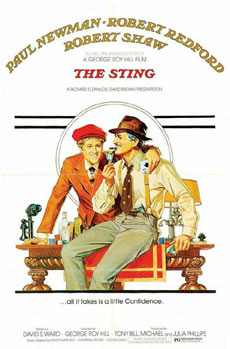The movie is based on the exploits of Charley and Fred Gondorf, who
engaged in a similar con, both of whom did time in Sing Sing. Information
came from the book The Big Con by David W. Maurer.
As the film opens, we meet Johnny Hooker (Redford), a smalltime con
man who crosses the wrong guy, criminal banker Doyle Lonnegan (Shaw).
After Lonnegan's men kill Hooker's partner, he finds himself on the
run and anxious for revenge.
To get even, he seeks the assistance of seasoned con man Henry Gondorff
(Newman), who used to run big cons until he got into trouble and went
into hiding. The plot they put together is a major operation, involving
dozens of hired actors, setting up elaborate fake locations, and finagling
their way into restricted areas to gain access to crucial information.
There are a lot of moving pieces, and a lot that could go wrong. The
audience watches anxiously, wondering if they can possibly pull it off.
Watching the movie again after so long, I was surprised once again
by the ending, and pleased. That's the best part of a con movie is getting
conned, and every con movie since The Sting has tried to achieve
the same result, many of them unsuccessfully. After all, it's become
a trope of the con movie, that key information is kept from the audience
so that they can be surprised.
The Sting is more about the plot than it is about anything else.
Even so, the on-screen chemistry between Redford and Newman helped to
drive the film. It's easy to get drawn into caring for those characters
and wanting them to succeed.
Great attention was paid to sets and costuming, hence the Oscar wins
in those categories. The film is set in the 1930s, and the director
received some criticism for using ragtime music (which comes from the
early 1900s), rather than 1930s jazz. But according to the making-of
documentary that accompanied the movie on the DVD, the director wanted
music that was playful. Unlike many other movies, no music underlies
the action. Instead, it's played between scenes, which draws more attention
to the music. Because of that, Scott
Joplin's "The Entertainer" became an unlikely pop hit.
In fact, few people can listen to that song today without thinking of
The Sting.
While The Sting is a much lighter film than those that typically
win Best Picture, it's a well-executed film. Don't forget: the movie
came out during the height of the Watergate
scandal, with the president of the United States being linked to
shady, illegal activities in an effect to win reelection. I'm sure that
audiences enjoyed watching a blustery crook get his comeuppance.
Incidentally, Lonnegan's limp came from the fact that Shaw injured
his ankle before the production. He got the part of Lonnegan after Richard
Boone and another actor declined it.
Writer David S. Ward got the idea for the movie while research pickpockets
for another movie. Researching this, Ward found himself reading about
con artists, which gave him the idea for the outline. He shared it with
Tony Bill, who liked it immediately and brought in Julia Phillips and
Michael Phillips; the three then produced both films.
Ward wrote the script with Robert Redford in mind as Hooker, but Redford
initially turned down the part, saying, he didn't expect the movie to
be a hit. Hill saw the screenplay by accident and asked for the director's
job. He showed the projects to Newman, who was pleased to join the project.
While Hill wanted to film the picture on location, but art director
Henry Bumstead felt it would be too hard to get the period appearance
right. Ultimately, the only location shooting was a few days' worth
in Chicago and Los Angeles; most of the exteriors were filmed on Universal's
back lot.
That's the secret to enjoying The Sting. Don't expect major
drama (although there are a few darker moments), and don't expect anything
terribly deep. Just expect to have a good time, and you won't be disappointed.
And remember, too, that all the con movies made in the last three decades
owe a debt to this film.


